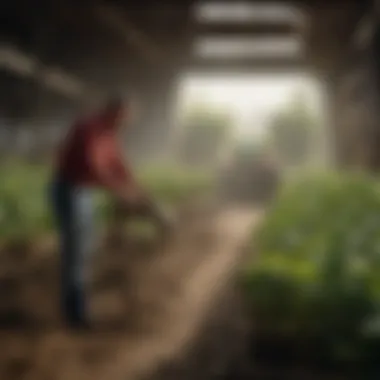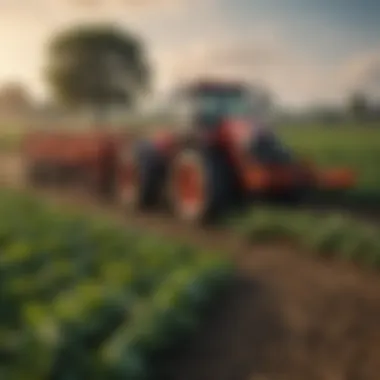Understanding 262 Help in Agriculture and Horticulture


Intro
The agricultural sector is complex and constantly evolving. Understanding the frameworks that support it can be challenging. One such framework is 262 Help, which plays a crucial role in guiding farmers and horticulturists today. This article explores various aspects of 262 Help, focusing on its significance, compliance requirements, available resources, and practical applications. 262 Help aids in enhancing productivity while maintaining sustainability in agriculture and horticulture.
Key Concepts and Terminology
Basic Definitions
To appreciate 262 Help, we must understand some basic terminology.
- 262 Help: Refers to a program designed to offer assistance in agricultural best practices, compliance with regulations, and access to necessary resources.
- Agriculture: The science or practice of farming, including cultivating soil for growing crops and raising animals for food.
- Horticulture: The art or practice of growing fruits, vegetables, nuts, seeds, mushrooms, herbs, sprouts, mushrooms, algae, flowers, seaweeds, and non-food crops such as grass and ornamental trees and plants.
Historical Context
The concept of 262 Help emerged as a response to the increasing complexity of regulations governing agriculture. Farmers began to seek guidance to navigate these complexities effectively. Over the years, various initiatives have been incorporated into 262 Help to address challenges in productivity and environmental sustainability. The need for this assistance arose as global agricultural practices evolved, making compliance with regulations more challenging for individual farmers.
Recent Innovations and Trends
Technological Advancements
Recent innovations in agriculture and horticulture have reshaped how farmers utilize resources. Technologies such as precision agriculture, data analytics, and automated machinery enhance decision-making processes. These innovations align closely with the objectives of 262 Help, providing farmers with tools to improve their efficiency and reduce waste.
Sustainable Practices
Sustainable agriculture practices are becoming essential to meet global food demands while minimizing environmental impact. 262 Help encourages methods such as crop rotation, organic farming, and integrated pest management. By adopting these practices, farmers can enhance productivity and contribute positively to ecological health.
Practical Applications and Techniques
Step-by-step Guides
To maximize the benefits of 262 Help, farmers can follow a systematic approach:
- Identify your needs: Develop a clear understanding of areas requiring assistance, whether it's compliance or resource access.
- Utilize available resources: Seek out resources offered under 262 Help, which could include training, funding, or consultation services.
- Implement best practices: Integrate sustainable techniques into daily operations to improve outcomes.
- Monitor progress: Regularly assess the effectiveness of implemented changes and adapt strategies accordingly.
Case Studies
Examining real-life scenarios offers invaluable insights. For instance, a farm utilizing 262 Help successfully improved yields after adopting precision irrigation techniques. The assistance not only facilitated access to the latest technologies but also educated them about sustainable practices. Documenting such cases showcases the tangible benefits of 262 Help in agriculture and horticulture.
"Implementing sustainable practices is not just a trend but a necessity for future food security."
Constant improvement in agricultural methods, guided by frameworks like 262 Help, is essential for sustaining food production in an ever-changing world. As farmers continue to adapt to new challenges, understanding this support system becomes crucial for achieving long-term success.
Prelims to Help
In agriculture and horticulture, improving methods and enhancing practices are vital for successful outcomes. The introduction of 262 Help presents unique opportunities in these fields. This concept revolves around understanding how it can support compliance, allocate resources better, and ultimately lead to productive and sustainable outcomes.
Definition and Overview
262 Help refers to the structured support mechanisms available for farmers and horticulturists. These mechanisms can encompass various forms of assistance, including technical guidance, compliance advice, and access to financial resources. This assistance aims to improve productivity in agriculture and horticulture. With effective utilization of these resources, farmers can navigate complex regulations, optimize their operations, and implement sustainable practices. Understanding this support empowers farmers to make informed decisions, enhancing both yield and resource management.
Historical Context
To fully appreciate the significance of 262 Help, it is important to contextualize it within the historical framework of agricultural practices. Over the years, the agricultural sector has undergone significant transformations driven by technological advancements and changing market demands. Historically, farmers relied on traditional techniques and local knowledge, often lacking formal assistance.
As agricultural practices evolved, so did the need for guidance and support. Regulations emerged to ensure safety, sustainability, and quality. In response, initiatives like 262 Help were developed to bridge the gaps between regulatory requirements and practical application. This historical evolution highlights a continuous progression toward more professional and accountable practices in agriculture, positioning 262 Help as a crucial tool in modern farming.
Importance of Help in Agriculture


The significance of 262 Help in agriculture cannot be overstated. This framework illuminates pathways for improving efficiency, compliance, and sustainability, thereby enhancing overall productivity. Understanding these benefits becomes essential for farmers and agricultural professionals aiming for optimized operations. The emphasis on adherence to regulations and proper resource management illustrates how 262 Help serves as a backbone for contemporary agricultural practices.
Regulatory Compliance
Regulatory frameworks in agriculture are complex and constantly evolving. 262 Help plays a critical role in ensuring that farmers remain compliant with these regulations. For instance, it provides guidance on various environmental and safety standards, helping to mitigate risks associated with non-compliance.
The integration of 262 Help into farming operations fosters a culture of accountability. This helps farmers understand their responsibilities regarding environmental practices, chemical usage, and labor policies. Some key points include:
- Knowledge Access: Provides information on the latest regulations and best practices.
- Training Programs: Offers structured training to ensure that farmers and workers are well-informed.
- Monitoring Systems: Supports the establishment of monitoring systems to track compliance.
By adhering to these set frameworks, farmers not only avoid potential penalties but also enhance their reputation in the industry. Effective regulatory compliance can foster relationships with consumers who increasingly prioritize sustainable and ethically produced goods.
Resource Allocation
Resource allocation is another crucial area where 262 Help proves beneficial. Efficient use of resources such as water, soil, and labor directly affects the profitability of agricultural operations. Poor management can lead to wastage and increased costs, ultimately reducing the competitive edge of farming enterprises.
Implementing 262 Help encourages a strategic approach toward resource management. The key components of effective resource allocation include:
- Optimal Planning: Analyzing data to allocate resources where they are most needed.
- Financial Management: Guidance on budgeting and financial planning to ensure sustainability.
- Technology Integration: Utilizing modern agricultural technologies for precision farming.
These aspects lead to better economic outcomes and promote a culture of sustainability among farming communities. As a result, farmers can ensure that their operations are not only financially viable but also environmentally friendly.
In summary, 262 Help lays the groundwork for efficient agricultural practices. Its relevance is undeniable, as it fosters compliance and optimizes resource allocation, both of which are crucial for the success of modern farming.
Help and Sustainability
The integration of 262 Help within agricultural frameworks plays a crucial role in advancing sustainability. This approach emphasizes the need for environmentally friendly practices while simultaneously enhancing productivity. Understanding how 262 Help relates to sustainability is key for farmers looking to optimize their operations and contribute positively to their communities and best practices.
Understanding Sustainable Practices
Sustainable practices in agriculture focus on meeting the needs of the present without compromising the ability of future generations to meet their own needs. This concept encompasses a variety of methods that aim to reduce environmental impact while maintaining economic viability. Some key elements include:
- Crop Rotation: This prevents soil depletion and reduces pest buildup.
- Organic Farming: Using natural fertilizers and pesticides enhances soil health and biodiversity.
- Water Management: Efficient irrigation systems conserve water and reduce waste.
- Integrated Pest Management: This minimizes chemical use and promotes the natural predator population.
By utilizing 262 Help resources, farmers can gain insights into best sustainability practices tailored to their specific local conditions. This enhances both immediate farm output and long-term ecological health.
Implementation Strategies
Implementing sustainable strategies can be challenging, but 262 Help offers a pathway for effective transitions. Here are practical steps and strategies that assist this process:
- Assessment of Current Practices: Farmers should evaluate their existing practices to identify areas for improvement. Tools and resources provided by 262 Help can aid in this analysis.
- Education and Training: Engaging in local workshops or online training can elevate farmer knowledge about sustainable techniques. Many organizations collaborating with 262 Help offer tailored educational programs.
- Collaboration with Local Experts: Partnering with agricultural advisors or local extension services can provide critical insights into implementing changes.
- Funding and Resource Access: Explore available grants or funding opportunities within the scope of 262 Help to finance needed changes.
- Monitoring and Evaluation: Establishing metrics to evaluate the effectiveness of implemented changes is vital. Systematic monitoring can be facilitated by tools mentioned within the 262 Help framework.
"Sustainability is not just about conservation; it's about crafting a resilient agricultural future that supports both growth and ecological balance."
By following these steps and leveraging the tools provided by 262 Help, farmers can move towards more sustainable practices effectively. This not only enhances individual farm resilience but also contributes to a broader environmental responsibility.
Case Studies Demonstrating Help Effectiveness
The examination of case studies in relation to 262 Help is pivotal to understanding its practical outcomes in real-world scenarios. By showcasing successful implementations, we can discern effective strategies and pinpoint challenges faced by various agricultural entities. These case studies not only illustrate how 262 Help contributes to improved productivity but also underscore the diverse applications of such assistance across different farming contexts.
Successful Implementations
Farm One: Crop Yield Improvements
Farm One serves as an instructive example of how 262 Help yields tangible crop improvements. This farm implemented advanced agricultural techniques supported by 262 Help to enhance soil health and increase yield per acre. A notable aspect of Farm One is its focus on integrating cover cropping and precision agriculture, allowing for better resource management.
A key characteristic of this initiative is the emphasis placed on data-driven decisions. By utilizing technologies such as soil sensors and satellite imagery, Farm One achieved a measurable increase in crop yields of approximately 20%. This demonstrates the effectiveness of combining traditional farming methods with modern analytics.
The unique feature of Farm One’s approach lies in its collaborative network with local agricultural advisers. This partnership not only facilitated knowledge exchange but also provided tailored solutions to specific agricultural challenges faced by the farm. The primary advantage of this collaborative effort includes the ability to adapt practices based on real-time data, thus enhancing overall productivity. However, a potential drawback could include the reliance on technology, which may not be feasible for all farms.


Farm Two: Resource Efficiency
Farm Two illustrates the role of 262 Help in enhancing resource efficiency. This farm focused on optimizing water use and reducing waste through the deployment of drip irrigation systems supported by consultancy services obtained via 262 Help. The implementation of this system enabled Farm Two to minimize water usage by 30%, effectively reducing both costs and environmental impact.
A crucial characteristic of Farm Two's strategy is the emphasis on sustainability. By prioritizing efficient resource use, the farm has positioned itself as a leader in environmentally conscious farming practices. This not only aligns with broader sustainability goals but also attracts customers interested in responsibly sourced products.
The distinctive feature of this operation is its comprehensive training programs for staff. These programs ensure all team members understand the system's functioning and maintenance, contributing to long-term operational success. A major advantage is the high level of productivity achieved without exhausting natural resources. Nevertheless, the upfront investment required for installation can be a significant barrier for some small-scale farmers.
Lessons Learned
Examining the successes and challenges faced by these farms provides valuable insights for future initiatives. Firstly, leveraging technology in conjunction with traditional farming practices proves beneficial. Collaborative environments, where knowledge flows between farmers and experts, often yield the best results.
Additionally, emphasizing sustainability and efficiency not only enhances productivity but also fosters a positive public image. Training and education remain critical components for ensuring all workers are equipped to maximize these systems' effectiveness. Overall, 262 Help serves as a transformative tool in adapting agricultural practices to meet today's demands.
Challenges Facing Help Initiatives
The provision of 262 Help in agriculture and horticulture is an important topic deserving of attention, especially given its potential implications for productivity and sustainability. However, despite the numerous advantages it offers, there are several challenges that hinder its effective implementation. Identifying these challenges is crucial for developing strategies that can overcome them. The challenges can be broadly divided into two categories: technical barriers and community engagement issues.
Technical Barriers
Technical barriers encompass a range of obstacles that can impede the successful implementation of 262 Help initiatives. These issues often stem from insufficient infrastructure, lack of access to technology, and inadequate training for those involved in agricultural practices.
One significant hurdle is the availability of relevant technology. Many farmers may not have access to the latest agricultural tools or digital resources designed to facilitate their understanding and application of 262 Help. This can result in inefficient practices and a lack of awareness about the full scope of support available.
Furthermore, knowledge gaps can exist, affecting the ability of farmers to effectively utilize assistance programs. Without proper training, individuals may find it difficult to implement innovative practices that are part of 262 Help. This disconnect between theoretical knowledge and practical application can stifle potential growth and efficiency within agricultural systems.
Community Engagement Issues
Community engagement issues represent another crucial challenge. Successful initiatives often depend on strong relationships among stakeholders, including farmers, local agencies, and community organizations. However, barriers such as mistrust, lack of communication, and inadequate participation can complicate these relationships.
The hesitation of farmers to adopt new practices can be rooted in historical experiences and skepticism towards governmental programs. Building trust is an essential step in addressing these concerns. Moreover, engagement often requires significant effort in organizing outreach programs and educational initiatives. Without substantial investment in community involvement, the benefits of 262 Help may remain unutilized.
Additionally, differing priorities among community members can create friction, with some individuals perceiving 262 Help as less relevant to their immediate concerns. It is vital for those advocating for 262 Help to understand and address the unique needs of their communities to foster broader acceptance and active participation.
"Understanding the barriers to effective community engagement is as crucial as addressing technical shortcomings in agricultural initiatives."
Addressing the challenges of technical barriers and community engagement issues is essential for maximizing the impact of 262 Help in agriculture and horticulture. By fostering a better understanding of these issues, stakeholders can work cooperatively to develop targeted solutions that enhance productivity and sustainability.
Future Directions of Help
The concept of 262 Help is essential for advancing agricultural practices that meet modern challenges. As the agricultural sector continues to evolve, understanding future directions is crucial. This section will explore innovative approaches and potential for expansion, both of which hold great relevance for practitioners and researchers.
Innovative Approaches
In the context of 262 Help, innovative approaches represent the adaptation of technology and methods that enhance productivity. Precision agriculture is one area where such innovation thrives. Utilizing advanced tools like drones and soil sensors allows farmers to maximize efficiency. These tools help in closely monitoring crop health, soil conditions, and water usage.
Moreover, data analytics is becoming increasingly important. Farmers can collect and analyze data to make informed decisions about planting and resource allocation. This can lead to better crop yields and minimize waste.
Another noteworthy approach is the incorporation of sustainable practices. By adopting regenerative agricultural techniques, farmers can improve soil health, enhance biodiversity, and reduce input costs. The application of cover crops and crop rotation are examples of such methods. These practices not only benefit the environment but also increase resilience against climate change impacts.
Potential for Expansion
The potential for expansion of 262 Help relates to its adaptability across various scales of farming. Both small-scale farmers and larger agricultural enterprises can benefit from tailored assistance programs. Recognizing the unique needs of different farming operations is key to ensuring success.
Policies supporting 262 Help initiatives can be expanded regionally and internationally. Countries that face similar agricultural challenges can share best practices and resources. This collaboration can foster innovation and lead to improved outcomes in various environmental contexts.
Expanding the reach and effectiveness of 262 Help can help address global food security issues and empower farmers worldwide.


Furthermore, educational programs designed to inform farmers about 262 Help tools and techniques are critical. These programs can enhance community engagement and provide practical knowledge that enables farmers to implement more effective practices. Online platforms and workshops can facilitate this learning experience and broaden the audience.
In summation, the future of 262 Help in agriculture hinges on innovative approaches and a commitment to expansion. Farmers and stakeholders must remain aware of emerging technologies and practices to harness the full potential of 262 Help for improved productivity and sustainability.
Epilogue
In summarizing the critical aspects of 262 Help, it becomes evident that this initiative plays a pivotal role in modern agriculture and horticulture. The implications of effective implementation extend beyond immediate compliance and resource allocation. A thorough understanding and application of 262 Help can lead to significant enhancements in sustainability and productivity within these sectors.
Summary of Key Points
The essence of 262 Help rests on several important elements:
- Regulatory Compliance: Understand how 262 Help aids farmers in meeting legal requirements, resulting in fewer penalties and better operational practices.
- Resource Optimization: By making effective use of available resources, farmers can achieve more with less, thus reducing waste and improving profitability.
- Sustainable Practices: Emphasis is placed on integrating environmentally-friendly methods that ensure long-term viability of agricultural systems.
- Real-World Applications: The case studies examined demonstrate tangible benefits, showing that theory translates to practice effectively.
"Understanding and applying 262 Help can help farmers not just to survive but to thrive in a competitive landscape."
Call to Action for Practitioners
As the landscape of agriculture evolves, it is crucial for farmers and practitioners to actively engage with 262 Help initiatives. Here are some suggestions:
- Educate Yourself: Stay informed about the latest developments in regulations and practices relating to 262 Help.
- Engage with Resources: Utilize online courses and reading materials to deepen your knowledge of sustainable agricultural practices.
- Participate in Community Discussions: Join forums and discussions on platforms such as Reddit or Facebook to share experiences and learn from others in the field.
- Implement Changes: Evaluate current farming practices and consider how you can incorporate lessons from 262 Help to enhance your operations.
Moving forward, the potential for 262 Help to reshape agricultural practices is substantial. By applying the insights shared, practitioners can significantly impact both their immediate practices and the broader agricultural community.
Appendix A: Resources for Further Reading
Resources are essential in the context of 262 Help as they offer additional avenues for learning and understanding. This is particularly relevant for farmers and horticulturists seeking to implement effective strategies in their practices. By diving into various materials, practitioners can deepen their knowledge, stay updated with the latest trends, and enhance their decision-making capabilities.
Moreover, dedicated reading materials and educational assets help demystify complex aspects of 262 Help in agriculture and horticulture. Engaging with curated resources fosters a culture of continuous improvement and innovation within the agricultural sector. This section aims to guide readers towards quality resources that will aid in their journey of understanding and applying 262 Help effectively.
Books on Agricultural Practices
Books provide a wealth of information and perspectives on agricultural practices and trends related to 262 Help. Here are several notable titles:
- "The Organic Farmer's Business Handbook" by John F. McCauley: This book offers insights on the economics of organic farming, which aligns with sustainable practices promoted by 262 Help.
- "Sustainable Agriculture: A Systems Approach" by John H. L. Coutts: This work provides a comprehensive overview of sustainable techniques, relevant for implementing 262 Help strategies.
- "Soil Science Simplified" by A. J. W. J. B. C. A. R. Alakrijia: Understanding soil health is crucial for successful agricultural output, making this book valuable.
Engaging with these texts allows farmers to contextualize the application of 262 Help and develop more effective methodologies in their work.
Online Courses and Webinars
Online courses and webinars are excellent platforms for further education regarding 262 Help. They allow farmers and horticulturalists to learn at their own pace and access expert knowledge in real time. Here are some recommended online resources:
- Coursera: Offers courses on agricultural sustainability and practices tailored to modern farming challenges. Topics often include ways to integrate compliance measures pertaining to 262 Help.
- edX: Provides specialized programs focused on horticulture and sustainable agriculture. These courses often have contributions from established universities.
- Local Extension Services: Many agricultural extension programs host webinars focusing on practical applications of 262 Help. Participating in these webinars can provide immediate insights and practical techniques tailored for specific environments.
Taking the time to engage with these resources can lead to improved practices, efficiency, and knowledge application in the field.
By investing in these resources, practitioners not only enhance their knowledge but also create a more informed community in the agricultural landscape.
Frequently Asked Questions About Help
Understanding 262 Help is essential for those involved in agriculture and horticulture. This section addresses common questions that farmers and practitioners frequently ask. By clarifying these points, we can untangle complex aspects and promote better decision-making.
What is the scope of Help?
The scope of 262 Help encompasses various aspects of agricultural support. It provides guidelines, resources, and compliance measures that help farmers navigate the intricacies of modern agriculture.
Key elements include:
- Regulatory guidance: Helping farmers adhere to local and international farming laws.
- Resource allocation: Ensuring optimal use of resources like soil, water, and labor which is critical in achieving high productivity levels.
- Sustainability practices: Encouraging methods that contribute to environmental preservation.
- Educational support: Offering training and workshops to equip farmers with necessary skills.
Farmers must be aware of all available options under 262 Help. Understanding these can increase farm productivity and efficiency, making operational practices more sustainable.
How can farmers access Help?
Accessing 262 Help can be a straightforward process if farmers know where to look. Here are some common avenues for obtaining assistance:
- Local agricultural offices: These institutions can provide direct information regarding eligibility and application processes.
- Online platforms: Websites dedicated to agricultural support often contain detailed guidelines and resources. Farmers can visit service portals for quick help.
- Community organizations: Many groups work directly with farmers to offer support and guidance.
- Workshops and seminars: Attending these events helps in gaining insights and direct contacts with experts in the field.
Effective engagement with these resources is crucial for maximally benefiting from 262 Help. Timely access is essential, as applications or assistance might be time-sensitive.















